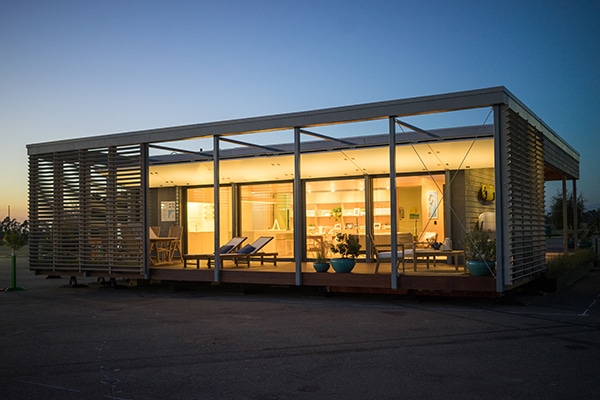Every year, the US Department of Energy challenges 20 collegiate teams to design, build, and operate a cost-effective, energy-efficient, and aesthetically pleasing solar-powered home. The teams spend nearly two years designing and building the projects, which are eventually judged in 10 different areas with one winner coming out on top. 2015’s victors, Stevens Institute of Technology, originally began with a simple question, asking themselves: “How can we design a home that both reduces its energy use and adapts to the realities of a changing, more extreme climate?”
The answer manifested in the form of a storm-resilient, ‘60s style modern beach house cottage dubbed SU+RE thanks to its marriage of sustainability and resiliency.
The fully solar-powered home is fit for battle against extreme weather, uses 90% less energy than its conventional cousins, and in the wake of a major weather event, becomes a hub for emergency power for its neighborhood. Here, we had the SU+RE team define three terms that shed a little light on just how this modern marvel gets the job done.

The SU+RE house is fully solar-powered, storm-resilient, uses 90% less energy than a conventional home, and in the wake of a major weather event, becomes a hub for emergency power for its neighborhood.
Ventilation \ven(t)əˈlāSH(ə)n/ (noun)
The provision of fresh air to a room, building, etc. The SU+RE House’s Heat Recovery Ventilation system runs 24 hours a day, 7 days a week to provide clean, filtered air to the home while extracting stale air from the kitchen and bathroom, all the while using a wildly small amount of energy and saving heat from the exhausting air (resulting in the 90% decrease in heating and cooling energy needs).
Elevation \eləˈvāSH(ə)n/(noun)
The height of a place. FEMA requires that all homes in flood-susceptible communities be elevated up above the designated Base Flood Elevation (BEF), and in these zones, all new construction must be elevated on pilings or columns so that the bottom of the structure is out of harm’s way. In the case of SU+RE, the house is rated to withstand up to about six feet of water.

Islanding ˈīlənd/iNG (noun)
The condition in which power continues to be generated even if the source of power is no longer present. When extreme weather takes the grid down, traditional Photovoltaic systems stop creating usable energy at one of the worst possible times. In this project’s case, the PV system is designed to allow a small amount of “islanded” energy—energy that’s cut off from the main grid—to generate during a power-outage, sans batteries.

